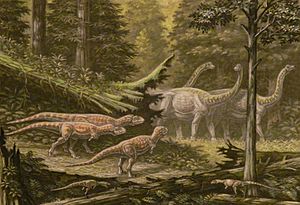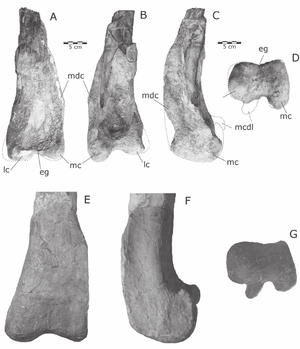Quilmesaurus facts for kids
Quick facts for kids QuilmesaurusTemporal range: Late Cretaceous
|
|
|---|---|
 |
|
| Scientific classification | |
| Kingdom: | |
| Phylum: | |
| Class: | |
| Superorder: | |
| Order: | |
| Suborder: | |
| Infraorder: | |
| Genus: |
Quilmesaurus
Coria, 2001
|
| Species | |
|
Q. curriei Coria, 2001 (type) |
|
Quilmesaurus was a predatory dinosaur that lived during the Cretaceous period. This meat-eating dinosaur roamed the Earth about 95 million years ago. Its fossils were found in what is now Argentina, in South America.
What Quilmesaurus Looked Like
Scientists can learn a lot about a dinosaur from its bones. The leg bones of Quilmesaurus were very strong and thick. The lower part of its thigh bone, called the femur, was quite boxy. This part had special bumps, called condyles, which helped it connect to the lower leg bones. These lower leg bones are the tibia (the main shin bone) and the fibula (a thinner bone next to the tibia).
One of the condyles, which connected to the fibula, was a bit lower but wider than the other. There might have also been a small, finger-like bone spur on this part, though it was broken off in the only known fossil. Just above the other condyle, there was a small ridge sticking out. Overall, the thigh bone of Quilmesaurus looked very similar to those of other dinosaurs in the abelisaurid family.
The upper part of the shin bone, called the tibia, also had some interesting features. It had a large, hatchet-shaped part pointing forward, known as a cnemial crest. The tip of this crest was hooked, with a small spur pointing downwards. At first, scientists thought this hooked crest was unique to Quilmesaurus. However, later studies showed that other abelisaurid dinosaurs, like Aucasaurus and Majungasaurus, also had similar features.
The very bottom part of the tibia had its own bumps, called malleoli, which connected to the ankle bones. This part looked like a triangle from the front. The outer malleolus was larger and stuck out more than the inner one. Again, this feature was once thought to be special to Quilmesaurus, but it was later found in other dinosaurs like Rajasaurus.
In 2016, scientists estimated that Quilmesaurus was about 5.3 meters (about 17.4 feet) long. This made it one of the smaller abelisaurids. However, its legs were very strong and thick, similar to those of Pycnonemosaurus, which was one of the largest dinosaurs in its family.
Images for kids
See also
 In Spanish: Quilmesaurus curriei para niños
In Spanish: Quilmesaurus curriei para niños




